Renewed Interest in Spectroscopy of the Lightest Doubly-Odd N = Z Nuclei
Abstract
:1. Introduction
2. Level Schemes and Open Problems
2.1. Experimental Data about Li
2.2. Experimental Data about B
2.3. Experimental Data about N
3. Summary and Outlook
Author Contributions
Funding
Data Availability Statement
Conflicts of Interest
Abbreviations
| AMD | Antisymmetrized Molecular Dynamics |
| CKM | Cabibbo–Kobayashi–Maskawa (Matrix) |
| CVC | Conserved Vector Current |
| DSAM | Doppler-Shift Attenuation Method |
| EFT | Effective Field Theories |
| EM | Electromagnetic |
| ENSDF | Evaluated Nuclear Structure Data File |
| GDR | Giant Dipole Resonance |
| gs | Ground State |
| GT | Gamow–Teller |
| IAS | Isobaric Analog State |
| IMME | Isobaric Multiplet Mass Equation |
| INOY | Inside-Outside Yukawa |
| IVGDR | Isovector Giant Dipole Resonance |
| pn | Proton–Neutron (pair) |
| PNC | Parity Non-Conserving (Interaction) |
| NCSM | No-Core Shell Model Calculations |
| NN | Two-Nucleon (Interaction) |
| NRF | Nuclear Resonance Fluorescence |
| QCD | Quantum Chromodynamics |
| 3N | Three-Nucleon (Interaction) |
References
- Hergert, H. A Guided Tour of ab initio Nuclear Many-Body Theory. Front. Phys. 2020, 8, 379. [Google Scholar] [CrossRef]
- Tilley, D.R.; Cheves, C.M.; Godwin, J.L.; Hale, G.M.; Hofmann, H.M.; Kelley, J.H.; Sheu, C.G.; Weller, H.R. Energy levels of light nuclei A = 5, 6, 7. Nucl. Phys. A 2002, 708, 3–163. [Google Scholar] [CrossRef]
- Tilley, D.R.; Kelley, J.H.; Godwin, J.L.; Millener, D.J.; Purcell, J.E.; Sheu, C.G.; Weller, H.R. Energy levels of light nuclei A = 8, 9, 10. Nucl. Phys. A 2004, 745, 155–362. [Google Scholar] [CrossRef]
- Ajzenberg-Selove, F. Energy levels of light nuclei A = 13–15. Nucl. Phys. A 1976, 268, 1–204. [Google Scholar] [CrossRef]
- Heisenberg, W. Über den Bau der Atomkerne. I. Z. Phys. 1932, 77, 1–11. [Google Scholar] [CrossRef]
- Navrátil, P.; Ormand, W.E. Ab initio shell model with a genuine three-nucleon force for the p-shell nuclei. Phys. Rev. C 2003, 68, 034305. [Google Scholar] [CrossRef]
- Navrátil, P.; Gueorguiev, V.G.; Vary, J.P.; Ormand, W.E.; Nogga, A. Structure of A = 10–13 Nuclei with Two-Plus Three-Nucleon Interactions from Chiral Effective Field Theory. Phys. Rev. Lett. 2007, 99, 042501. [Google Scholar] [CrossRef]
- Wigner, E. Robert A. Welch Foundation Conference on Chemical Research; Milligan, W.O., Ed.; Welch Foundation: Houston, TX, USA, 1957; Volume 1, pp. 67–91. [Google Scholar]
- Bertsch, G.F.; Mekjian, A. Isospin Impurities in Nuclei. Annu. Rev. Nucl. Sci. 1972, 22, 25–64. [Google Scholar] [CrossRef]
- Bray, K.H.; Cameron, J.M.; Fearing, H.W.; Gill, D.R.; Sherif, H.S. Isospin Mixing of States in 6Li. Phys. Rev. C 1973, 8, 881–887. [Google Scholar] [CrossRef]
- Renan, M.J.; Sellschop, J.P.F.; Keddy, R.J.; Mingay, D.W. Isospin Impurity of the 6.88-MeV State in 10B. Phys. Rev. C 1972, 6, 12–17. [Google Scholar] [CrossRef]
- Renan, M.J.; Sellschop, J.P.F.; Keddy, R.J.; Mingay, D.W. Isospin mixing in 14N. Nucl. Phys. A 1972, 193, 470–478. [Google Scholar] [CrossRef]
- Kuvin, S.A.; Wuosmaa, A.H.; Lister, C.J.; Avila, M.L.; Hoffman, C.R.; Kay, B.P.; McNeel, D.G.; Morse, C.; McCutchan, E.A.; Santiago-Gonzalez, D.; et al. α decay of the T=1,2+ state in 10B and isospin symmetry breaking in the A=10 triplet. Phys. Rev. C 2017, 96, 041301. [Google Scholar] [CrossRef]
- Severijns, N.; Hayen, L.; De Leebeeck, V.; Vanlangendonck, S.; Bodek, K.; Rozpedzik, D.; Towner, I.S. Ft values of the mirror β transitions and the weak-magnetism-induced current in allowed nuclear β decay. Phys. Rev. C 2023, 107, 015502. [Google Scholar] [CrossRef]
- Ono, A.; Horiuchi, H.; Maruyama, T.; Ohnishi, A. Fragment formation studied with antisymmetrized version of molecular dynamics with two-nucleon collisions. Phys. Rev. Lett. 1992, 68, 2898–2900. [Google Scholar] [CrossRef] [PubMed]
- Kanada-En’yo, Y.; Horiuchi, H.; Ono, A. Structure of Li and Be isotopes studied with antisymmetrized molecular dynamics. Phys. Rev. C 1995, 52, 628–646. [Google Scholar] [CrossRef]
- Kanada-En’yo, Y.; Kimura, M.; Ono, A. Antisymmetrized molecular dynamics and its applications to cluster phenomena. Prog. Theor. Exp. Phys. 2012, 2012. [Google Scholar] [CrossRef]
- Morita, H.; Kanada-En’yo, Y. Isospin-projected antisymmetrized molecular dynamics and its application to 10B. Prog. Theor. Exp. Phys. 2016, 2016, 103D02. [Google Scholar] [CrossRef]
- Friman-Gayer, U.; Romig, C.; Hüther, T.; Albe, K.; Bacca, S.; Beck, T.; Berger, M.; Birkhan, J.; Hebeler, K.; Hernandez, O.J.; et al. Role of Chiral Two-Body Currents in 6Li Magnetic Properties in Light of a New Precision Measurement with the Relative Self-Absorption Technique. Phys. Rev. Lett. 2021, 126, 102501. [Google Scholar] [CrossRef]
- Munch, M.; Matei, C.; Pain, S.D.; Febbraro, M.T.; Chipps, K.A.; Karwowski, H.J.; Diget, C.A.; Pappalardo, A.; Chesnevskaya, S.; Guardo, G.L.; et al. Measurement of the 7Li(γ,t)4He ground-state cross section between Eγ=4.4 and 10 MeV. Phys. Rev. C 2020, 101, 055801. [Google Scholar] [CrossRef]
- Yamagata, T.; Nakayama, S.; Akimune, H.; Fujiwara, M.; Fushimi, K.; Greenfield, M.B.; Hara, K.; Hara, K.Y.; Hashimoto, H.; Ichihara, K.; et al. Excitations of the α cluster in A=6 and 7 nuclei. Phys. Rev. C 2004, 69, 044313. [Google Scholar] [CrossRef]
- Yamagata, T.; Nakayama, S.; Akimune, H.; Miyamoto, S. Effect of the nuclear medium on α-cluster excitation in 6Li. Phys. Rev. C 2017, 95, 044307. [Google Scholar] [CrossRef]
- Eigenbrod, F. Untersuchung der vier ersten angeregten Zustände des 6Li-Kernes durch Elektronenstreuung. Z. Phys. 1969, 228, 337–352. [Google Scholar] [CrossRef]
- Bergstrom, J.C.; Auer, I.P.; Hicks, R.S. Electroexcitation of the 0+ (3.562 MeV) level of 6Li and its application to the reaction 6Li(γ,π+)6He. Nucl. Phys. A 1975, 251, 401–417. [Google Scholar] [CrossRef]
- Raabe, R.; Büscher, J.; Ponsaers, J.; Aksouh, F.; Huyse, M.; Ivanov, O.; Lesher, S.R.; Mukha, I.; Pauwels, D.; Sawicka, M.; et al. Measurement of the branching ratio of the 6He β-decay channel into the α+d continuum. Phys. Rev. C 2009, 80, 054307. [Google Scholar] [CrossRef]
- Alburger, D.E. Half-life of 6He. Phys. Rev. C 1982, 26, 252–253. [Google Scholar] [CrossRef]
- Wilkinson, D.H.; Alburger, D.E. Half-lives of 6He, 19Ne, and 42Scm. Phys. Rev. C 1974, 10, 1993–1995. [Google Scholar] [CrossRef]
- Kline, R.M.; Zaffarano, D.J. Decay Characteristics of Some Short-Lived Nuclides of Low Atomic Number. Phys. Rev. 1954, 96, 1620. [Google Scholar] [CrossRef]
- Bienlein, J.K.; Pleasonton, F. The half-life of 6He. Nucl. Phys. 1962, 37, 529–534. [Google Scholar] [CrossRef]
- Barker, P.H.; Ko, T.B.; Scandle, M.J. The half-life of 6He. Nucl. Phys. A 1981, 372, 45–50. [Google Scholar] [CrossRef]
- Kanafani, M.; Fléchard, X.; Naviliat-Cuncic, O.; Chung, G.D.; Leblond, S.; Liénard, E.; Mougeot, X.; Quéméner, G.; Simancas Di Filippo, A.; Thomas, J.C. High-precision measurement of the 6He half-life. Phys. Rev. C 2022, 106, 045502. [Google Scholar] [CrossRef]
- Knecht, A.; Zumwalt, D.W.; Delbridge, B.G.; García, A.; Harper, G.C.; Hong, R.; Müller, P.; Palmer, A.S.C.; Robertson, R.G.H.; Swanson, H.E.; et al. A high-intensity source of 6He atoms for fundamental research. Nucl. Instrum. Methods Phys. Res. A 2011, 660, 43–47. [Google Scholar] [CrossRef]
- Knecht, A.; Hong, R.; Zumwalt, D.W.; Delbridge, B.G.; García, A.; Müller, P.; Swanson, H.E.; Towner, I.S.; Utsuno, S.; Williams, W.; et al. Precision Measurement of the 6He Half-Life and the Weak Axial Current in Nuclei. Phys. Rev. Lett. 2012, 108, 122502. [Google Scholar] [CrossRef] [PubMed]
- Feynman, R.P.; Gell-Mann, M. Theory of the Fermi Interaction. Phys. Rev. 1958, 109, 193–198. [Google Scholar] [CrossRef]
- Sudarshan, E.C.G.; Marshak, R.E. Chirality Invariance and the Universal Fermi Interaction. Phys. Rev. 1958, 109, 1860–1862. [Google Scholar] [CrossRef]
- Holstein, B.R. Induced Coulomb corrections to nuclear beta decay. Phys. Rev. C 1974, 10, 1215–1219. [Google Scholar] [CrossRef]
- González-Alonso, M.; Naviliat-Cuncic, O.; Severijns, N. New physics searches in nuclear and neutron β decay. Prog. Part. Nucl. Phys. 2019, 104, 165–223. [Google Scholar] [CrossRef]
- Wu, C.S. The Universal Fermi Interaction and the Conserved Vector Current in Beta Decay. Rev. Mod. Phys. 1964, 36, 618–632. [Google Scholar] [CrossRef]
- Suzuki, Y.; Yabana, K. Isobaric analogue halo states. Phys. Lett. B 1991, 272, 173–177. [Google Scholar] [CrossRef]
- Li, Z.; Liu, W.; Bai, X.; Wang, Y.; Lian, G.; Li, Z.; Zeng, S. First observation of neutron–proton halo structure for the 3.563 MeV 0+ state in 6Li via 1H(6He,6Li)n reaction. Phys. Lett. B 2002, 527, 50–54. [Google Scholar] [CrossRef]
- Meyerhof, W.E.; Chase, L.F. Levels of Be10 and B10. Phys. Rev. 1958, 111, 1348–1357. [Google Scholar] [CrossRef]
- Sprenkel, E.L.; Daughtry, J.W. Gamma-Ray Studies in Boron-10. Phys. Rev. 1961, 124, 854–859. [Google Scholar] [CrossRef]
- Hornyak, W.F.; Ludemann, C.A.; Roush, M.L. Energy levels of B10. Nucl. Phys. 1964, 50, 424–449. [Google Scholar] [CrossRef]
- Segel, R.E.; Singh, P.P.; Hanna, S.S.; Grace, M.A. Gamma Rays from B10+p; Decay Schemes and Excitation Functions. Phys. Rev. 1966, 145, 736–745. [Google Scholar] [CrossRef]
- Warburton, E.K.; Olness, J.W.; Bloom, S.D.; Poletti, A.R. E2 and M1 Matrix Elements in B10. Phys. Rev. 1968, 171, 1178–1187. [Google Scholar] [CrossRef]
- Young, F.C.; Hornyak, W.F. 10B Gamma-Ray Branching Ratios. Nucl. Phys. A 1969, 124, 469–474. [Google Scholar] [CrossRef]
- McCutchan, E.A.; Lister, C.J.; Elvers, M.; Savran, D.; Greene, J.P.; Ahmed, T.; Ahn, T.; Cooper, N.; Heinz, A.; Hughes, R.O.; et al. Precise γ-ray intensity measurements in 10B. Phys. Rev. C 2012, 86, 057306. [Google Scholar] [CrossRef]
- Forsyth, P.D.; Tu, H.T.; Hornyak, W.F. The 6Li(α, γ)10B reaction and the energy levels of 10B. Nucl. Phys. 1966, 82, 33–48. [Google Scholar] [CrossRef]
- Segel, R.E.; Siemssen, R.H. Gamma decay of the 5.16 MeV state in 10B. Phys. Lett. 1966, 20, 295–297. [Google Scholar] [CrossRef]
- Paul, P.; Fisher, T.R.; Hanna, S.S. Transition rates of analog levels in A = 10 nuclei. Phys. Lett. B 1967, 24, 51–53. [Google Scholar] [CrossRef]
- Keinonen, J.; Anttila, A. Gamma-transition strengths of T = 1 states in 10B. Nucl. Phys. A 1979, 330, 397–408. [Google Scholar] [CrossRef]
- Ricken, L.; Bohle, D.; Domogala, G.; Glasner, K.; Kuhlmann, E. Isoscalar E2 transition strengths in 10 ≦ A ≦ 48 nuclei. Z. Phys. A 1982, 306, 67–71. [Google Scholar] [CrossRef]
- Zeidman, B.; Geesaman, D.F.; Zupranski, P.; Segel, R.E.; Morrison, G.C.; Olmer, C.; Burleson, G.R.; Greene, S.J.; Boudrie, R.L.; Morris, C.L.; et al. Inelastic scattering of pions by 10B. Phys. Rev. C 1988, 38, 2251–2258. [Google Scholar] [CrossRef]
- Ent, R.; Berman, B.L.; Blok, H.P.; van den Brand, J.F.J.; Briscoe, W.J.; Jans, E.; Kramer, G.J.; Lanen, J.B.J.M.; Lapikás, L.; Norum, B.E.; et al. Deuteron Formation in the Reaction 12C(e,e′d)10BT=1. Phys. Rev. Lett. 1989, 62, 24–27. [Google Scholar] [CrossRef] [PubMed]
- Ansaldo, E.J.; Bergstrom, J.C.; Yen, R.; Caplan, H.S. Inelastic electron scattering from 10B. Nucl. Phys. A 1979, 322, 237–252, Erratum in Nucl. Phys. A 1980, 342, 532. [Google Scholar] [CrossRef]
- Hicks, R.S.; Button-Shafer, J.; Debebe, B.; Dubach, J.; Hotta, A.; Huffman, R.L.; Lindgren, R.A.; Peterson, G.A.; Singhal, R.P.; de Jager, C.W. Determination of single-nucleon wave functions by transverse electron scattering. Phys. Rev. Lett. 1988, 60, 905–908. [Google Scholar] [CrossRef] [PubMed]
- Cichocki, A.; Dubach, J.; Hicks, R.S.; Peterson, G.A.; de Jager, C.W.; de Vries, H.; Kalantar-Nayestanaki, N.; Sato, T. Electron scattering from 10B. Phys. Rev. C 1995, 51, 2406–2426. [Google Scholar] [CrossRef]
- Rosen, M.; Raphael, R.; Überall, H. Generalized Helm Model for Transverse Electroexcitation of Nuclear Levels. Phys. Rev. 1967, 163, 927–934. [Google Scholar] [CrossRef]
- Sato, T.; Odagawa, N.; Ohtsubo, H.; Lee, T.S. Nuclear structure of 10B studied with (e,e′), (π,π′) and (γ,π) reactions. Nucl. Phys. A 1994, 577, 219–224. [Google Scholar] [CrossRef]
- McCutchan, E.A.; Lister, C.J.; Wiringa, R.B.; Pieper, S.C.; Seweryniak, D.; Greene, J.P.; Carpenter, M.P.; Chiara, C.J.; Janssens, R.V.F.; Khoo, T.L.; et al. Precise Electromagnetic Tests of Ab Initio Calculations of Light Nuclei: States in 10Be. Phys. Rev. Lett. 2009, 103, 192501. [Google Scholar] [CrossRef]
- McCutchan, E.A.; Lister, C.J.; Pieper, S.C.; Wiringa, R.B.; Seweryniak, D.; Greene, J.P.; Bertone, P.F.; Carpenter, M.P.; Chiara, C.J.; Gürdal, G.; et al. Lifetime of the 21+ state in 10C. Phys. Rev. C 2012, 86, 014312. [Google Scholar] [CrossRef]
- Riley, P.J.; Braben, D.W.; Neilson, G.C. The 5.11 and 5.16 MeV levels of B10. Nucl. Phys. 1963, 47, 150–156. [Google Scholar] [CrossRef]
- Alburger, D.E.; Parker, P.D.; Bredin, D.J.; Wilkinson, D.H.; Donovan, P.F.; Gallmann, A.; Pixley, R.E.; Chase, L.F.; McDonald, R.E. Properties of the 4.77- and 5.16-MeV States of B10. Phys. Rev. 1966, 143, 692–711. [Google Scholar] [CrossRef]
- Wilkinson, D.H.; Clegg, A.B. XXVI. Isotopic spin relection rules-VI: The 6·88 MeV state of 10B. Philos. Mag. 1956, 1, 291–297. [Google Scholar] [CrossRef]
- Smirnova, N.A. Isospin-Symmetry Breaking within the Nuclear Shell Model: Present Status and Developments. Physics 2023, 5, 352–380. [Google Scholar] [CrossRef]
- Kuşoğlu, A.; Constantin, P.; Söderström, P.A.; Balabanski, D.; Cuciuc, M.; Aogaki, S.; Ban, R.; Borcea, R.; Corbu, R.; Costache, C.; et al. Ground-Breaking Developments in 10B with Proton Inelastic Scattering. Il Nuovo Cimento C. 2023. submitted. Available online: https://www.sif.it/riviste/sif/ncc/special_issues (accessed on 31 August 2023).
- Aogaki, S.; Balabanski, D.; Borcea, R.; Constantin, P.; Costache, C.; Cuciuc, M.; Kuşoğlu, A.; Mihai, C.; Mihai, R.; Stan, L.; et al. A setup for high-energy γ-ray spectroscopy with the ELI-NP large-volume LaBr3:Ce and CeBr3 detectors at the 9 MV Tandem accelerator at IFIN-HH. Nucl. Instrum. Methods Phys. Res. A 2023, 168628. [Google Scholar] [CrossRef]
- Freer, M.; Casarejos, E.; Achouri, L.; Angulo, C.; Ashwood, N.I.; Curtis, N.; Demaret, P.; Harlin, C.; Laurent, B.; Milin, M.; et al. α:2n:α Molecular Band in 10Be. Phys. Rev. Lett. 2006, 96, 042501. [Google Scholar] [CrossRef] [PubMed]
- Bohlen, H.G.; Dorsch, T.; Kokalova, T.; von Oertzen, W.; Schulz, C.; Wheldon, C. Structure of 10Be from the 12C(12C,14O)10Be reaction. Phys. Rev. C 2007, 75, 054604. [Google Scholar] [CrossRef]
- Suzuki, D.; Shore, A.; Mittig, W.; Kolata, J.J.; Bazin, D.; Ford, M.; Ahn, T.; Becchetti, F.D.; Beceiro Novo, S.; Ben Ali, D.; et al. Resonant α scattering of 6He: Limits of clustering in 10Be. Phys. Rev. C 2013, 87, 054301. [Google Scholar] [CrossRef]
- Caprio, M.A.; Fasano, P.J.; McCoy, A.E.; Maris, P.; Vary, J.P. Ab initio Rotation in 10Be. Bulg. J. Phys. 2019, 46, 445–454. [Google Scholar]
- Soić, N.; Blagus, S.; Bogovac, M.; Fazinić, S.; Lattuada, M.; Milin, M.; Miljanić, D.; Rendić, D.; Spitaleri, C.; Tadić, T.; et al. 6He+α clustering in 10Be. Europhys. Lett. 1996, 34, 7. [Google Scholar] [CrossRef]
- Milin, M.; Zadro, M.; Cherubini, S.; Davinson, T.; Di Pietro, A.; Figuera, P.; Miljanić, D.; Musumarra, A.; Ninane, A.; Ostrowski, A.N.; et al. Sequential decay reactions induced by a 18 MeV 6He beam on 6Li and 7Li. Nucl. Phys. A 2005, 753, 263–287. [Google Scholar] [CrossRef]
- Kuchera, A.N.; Rogachev, G.V.; Goldberg, V.Z.; Johnson, E.D.; Cherubini, S.; Gulino, M.; La Cognata, M.; Lamia, L.; Romano, S.; Miller, L.E.; et al. Molecular structures in T=1 states of 10B. Phys. Rev. C 2011, 84, 054615. [Google Scholar] [CrossRef]
- Uroić, M.; Miljanić, D.; Blagus, S.; Bogovac, M.; Skukan, N.; Soić, N.; Majer, M.; Milin, M.; Prepolec, L.; Lattuada, M.; et al. T = 1 isospin excitation spectrum in 10B. Int. J. Mod. Phys. E 2008, 17, 2345–2348. [Google Scholar] [CrossRef]
- Blank, B.; Aouadi, M.; Ascher, P.; Gerbaux, M.; Giovinazzo, J.; Grévy, S.; Nieto, T.K.; Dunlop, M.R.; Dunlop, R.; Laffoley, A.T.; et al. Branching ratio of the super-allowed β decay of 10C. Eur. Phys. J. A 2020, 56, 156. [Google Scholar] [CrossRef]
- Dunlop, M.R.; Svensson, C.E.; Ball, G.C.; Grinyer, G.F.; Leslie, J.R.; Andreoiu, C.; Austin, R.A.E.; Ballast, T.; Bender, P.C.; Bildstein, V.; et al. High-Precision Half-Life Measurements for the Superallowed β+ Emitter 10C: Implications for Weak Scalar Currents. Phys. Rev. Lett. 2016, 116, 172501. [Google Scholar] [CrossRef]
- Choudhary, P.; Srivastava, P.C.; Navrátil, P. Ab initio no-core shell model study of 10–14B isotopes with realistic NN interactions. Phys. Rev. C 2020, 102, 044309. [Google Scholar] [CrossRef]
- Keinonen, J.; Anttila, A.; Hentelä, R. 13C(p,γ)14N study of the 9.13-MeV state in 14N. Phys. Rev. C 1978, 17, 414–417. [Google Scholar] [CrossRef]
- Vartsky, D.; Goldberg, M.; Engler, G.; Goldschmidt, A.; Breskin, A.; Morgado, R.E.; Hollas, C.; Ussery, L.; Berman, B.L.; Moss, C. The total width of the 9.17 MeV level in 14N. Nucl. Phys. A 1989, 505, 328–336. [Google Scholar] [CrossRef]
- Barker, P.H.; Scott, A. Energy of the 9.17 MeV excited state of 14N. Phys. Rev. C 2001, 64, 064305. [Google Scholar] [CrossRef]
- King, J.D. Branching ratios for the decay of the 8.78 and 8.91 MeV states of 14N. Can. J. Phys. 1991, 69, 828–829. [Google Scholar] [CrossRef]
- Pruneau, C.; Chatterjee, M.B.; Rangacharyulu, C.; St-Pierre, C. Radiative decay of unbound levels in 14N. Can. J. Phys. 1985, 63, 1141–1147. [Google Scholar] [CrossRef]
- Rangacharyulu, C.; St-Pierre, C. Properties of 11.05 MeV state in 14N. Can. J. Phys. 1980, 58, 150–152. [Google Scholar] [CrossRef]
- Kozub, R.L.; Lin, J.; Mateja, J.F.; Lister, C.J.; Millener, D.J.; Warburton, E.K. Electromagnetic transitions in 14C and 14N. Phys. Rev. C 1981, 23, 1571–1580. [Google Scholar] [CrossRef]
- Nolan, F.M.; Bernard, G.H.; Norman, K.G. Spectroscopy of 14N by use of the 12C(3He,p)14N reaction. Nucl. Phys. A 1968, 117, 161–184. [Google Scholar] [CrossRef]
- Garcia, L.A.C.; Anderson, B.D.; Manley, D.M.; Baldwin, A.R.; Pourang, R.; Steinfelds, E.; Watson, J.W.; Lindgren, R.A.; Clausen, B.L.; Bacher, A.D.; et al. Identification of 4− states in the 14C(p,n)14N reaction at 135 MeV. Phys. Rev. C 1994, 50, 289–299. [Google Scholar] [CrossRef] [PubMed]
- True, W.W. Nitrogen-14 and the Shell Model. Phys. Rev. 1963, 130, 1530–1537. [Google Scholar] [CrossRef]
- Jänecke, J.; Yang, T.F.; Gray, W.S.; Polichar, R.M. Isospin Nonconservation in the Reactions 16O(d,α)14N*0+,T=1 and 12C(d,α)10B*0+,T=1. Phys. Rev. C 1971, 3, 79–83. [Google Scholar] [CrossRef]
- Duray, J.R.; Browne, C.P. Nonconservation of Isospin in the 14N(d,d′)14N Reaction. Phys. Rev. C 1970, 1, 776–786. [Google Scholar] [CrossRef]
- Aoki, Y.; Kato, S.; Kawa, J.; Okada, K.; Izumoto, T. Study of isospin forbidden and allowed transitions in 14N(d,d′)14N at Ed = 10.03 and 11.65 MeV. Phys. Let. B 1976, 61, 437–440. [Google Scholar] [CrossRef]
- Aoki, Y.; Sanada, J.; Yagi, K.; Kunori, S.; Higashi, Y.; Kato, S.; Kawa, J.; Okada, K.; Izumoto, T. Isospin non-conservation in the 14N(d,d′)14N reaction. Nucl. Phys. A 1979, 322, 117–130. [Google Scholar] [CrossRef]
- Schwenzel, J.; Glasner, K.; Niermann, P.; Kuhlmann, E. Isospin mixing observed in the reaction 12C(6Li,α)14N. Nucl. Phys. A 1981, 367, 145–156. [Google Scholar] [CrossRef]
- Wilkinson, D.H.; Bloom, S.D. Isotopic spin selection rules XI: The 8.06 and 6.23 MeV states of 14N. Philos. Mag. 1957, 2, 63–82. [Google Scholar] [CrossRef]
- Warburton, E.K.; Pinkston, W.T. Shell Model Assignments for the Energy Levels of C14 and N14. Phys. Rev. 1960, 118, 733–754. [Google Scholar] [CrossRef]
- Adelberger, E.G.; Hoodbhoy, P.; Brown, B.A. Parity mixing of elastic scattering resonances: General theory and application to 14N. Phys. Rev. C 1984, 30, 456–463. [Google Scholar] [CrossRef]
- Zeps, V.J.; Adelberger, E.G.; García, A.; Gossett, C.A.; Swanson, H.E.; Haeberli, W.; Quin, P.A.; Sromicki, J. Parity mixing of the 0+-0− I=1 doublet in 14N. Phys. Rev. C 1995, 51, 1494–1520. [Google Scholar] [CrossRef] [PubMed]
- Horoi, M.; Clausnitzer, G.; Brown, B.A.; Warburton, E.K. New calculations of the parity nonconservation matrix element for the JπT 0+1, 0−1 doublet in 14N. Phys. Rev. C 1994, 50, 775–783. [Google Scholar] [CrossRef]
- Bister, M.; Anttila, A.; Keinonen, J. Doppler-shift attenuation lifetimes in 14N derived from experimental stopping parameters. Phys. Rev. C 1977, 16, 1303–1308. [Google Scholar] [CrossRef]
- Rasmussen, V.K.; Metzger, F.R. Radiative width of the 2.31-MeV level in 14N. Phys. Rev. C 1975, 12, 706–707. [Google Scholar] [CrossRef]
- Jancovici, B.; Talmi, I. Tensor Forces and the β Decay of C14 and O14. Phys. Rev. 1954, 95, 289–291. [Google Scholar] [CrossRef]
- Negret, A.; Adachi, T.; Barrett, B.R.; Bäumer, C.; van den Berg, A.M.; Berg, G.P.A.; von Brentano, P.; Frekers, D.; De Frenne, D.; Fujita, H.; et al. Gamow-Teller Strengths in the A=14 Multiplet: A Challenge to the Shell Model. Phys. Rev. Lett. 2006, 97, 062502. [Google Scholar] [CrossRef]
- Giraud, S.; Zamora, J.C.; Zegers, R.G.T.; Bazin, D.; Ayyad, Y.; Bacca, S.; Beceiro-Novo, S.; Brown, B.A.; Carls, A.; Chen, J.; et al. β+ Gamow-Teller Strengths from Unstable 14O via the (d,2He) Reaction in Inverse Kinematics. Phys. Rev. Lett. 2023, 130, 232301. [Google Scholar] [CrossRef] [PubMed]
- Maris, P.; Vary, J.P.; Navrátil, P.; Ormand, W.E.; Nam, H.; Dean, D.J. Origin of the Anomalous Long Lifetime of 14C. Phys. Rev. Lett. 2011, 106, 202502. [Google Scholar] [CrossRef]
- Hardy, J.C.; Towner, I.S. Superallowed 0+ → 0+ nuclear β decays: 2020 critical survey, with implications for Vud and CKM unitarity. Phys. Rev. C 2020, 102, 045501. [Google Scholar] [CrossRef]
- Laffoley, A.T.; Svensson, C.E.; Andreoiu, C.; Austin, R.A.E.; Ball, G.C.; Blank, B.; Bouzomita, H.; Cross, D.S.; Diaz Varela, A.; Dunlop, R.; et al. High-precision half-life measurements for the superallowed Fermi β+ emitter 14O. Phys. Rev. C 2013, 88, 015501. [Google Scholar] [CrossRef]
- Voytas, P.A.; George, E.A.; Severin, G.W.; Zhan, L.; Knutson, L.D. Measurement of the branching ratio for the β decay of 14O. Phys. Rev. C 2015, 92, 065502. [Google Scholar] [CrossRef]
- Valverde, A.A.; Bollen, G.; Brodeur, M.; Bryce, R.A.; Cooper, K.; Eibach, M.; Gulyuz, K.; Izzo, C.; Morrissey, D.J.; Redshaw, M.; et al. First Direct Determination of the Superallowed β-Decay QEC Value for 14O. Phys. Rev. Lett. 2015, 114, 232502. [Google Scholar] [CrossRef] [PubMed]
- Eronen, T.; Gorelov, D.; Hakala, J.; Hardy, J.C.; Jokinen, A.; Kankainen, A.; Kolhinen, V.S.; Moore, I.D.; Penttilä, H.; Reponen, M.; et al. QEC values of the superallowed β emitters 10C, 34Ar, 38Ca, and 46V. Phys. Rev. C 2011, 83, 055501. [Google Scholar] [CrossRef]
- Mitsova, E.; Zaitsev, A.A.; Artemenkov, D.A.; Kornegrutsa, N.K.; Rusakova, V.V.; Stanoeva, R.; Zarubin, P.I.; Zarubina, I.G. Search for Decays of the 9B Nucleus and Hoyle State in 14N Nucleus Dissociation. Phys. Part. Nucl. 2022, 53, 456–460. [Google Scholar] [CrossRef]
- Zaitsev, A.A.; Artemenkov, D.A.; Bradnova, V.; Zarubin, P.I.; Zarubina, I.G.; Kattabekov, R.R.; Kornegrutsa, N.K.; Mamatkulov, K.Z.; Mitsova, E.K.; Neagu, A.; et al. Dissociation of relativistic 10B nuclei in nuclear track emulsion. Phys. Part. Nucl. 2017, 48, 960–963. [Google Scholar] [CrossRef]
- Artemenkov, D.A.; Shchedrina, T.V.; Stanoeva, R.; Zarubin, P.I. Clustering Features of 9Be, 14N, and 8B Nuclei in Relativistic Fragmentation. AIP Conf. Proc. 2007, 912, 78–87. [Google Scholar] [CrossRef]
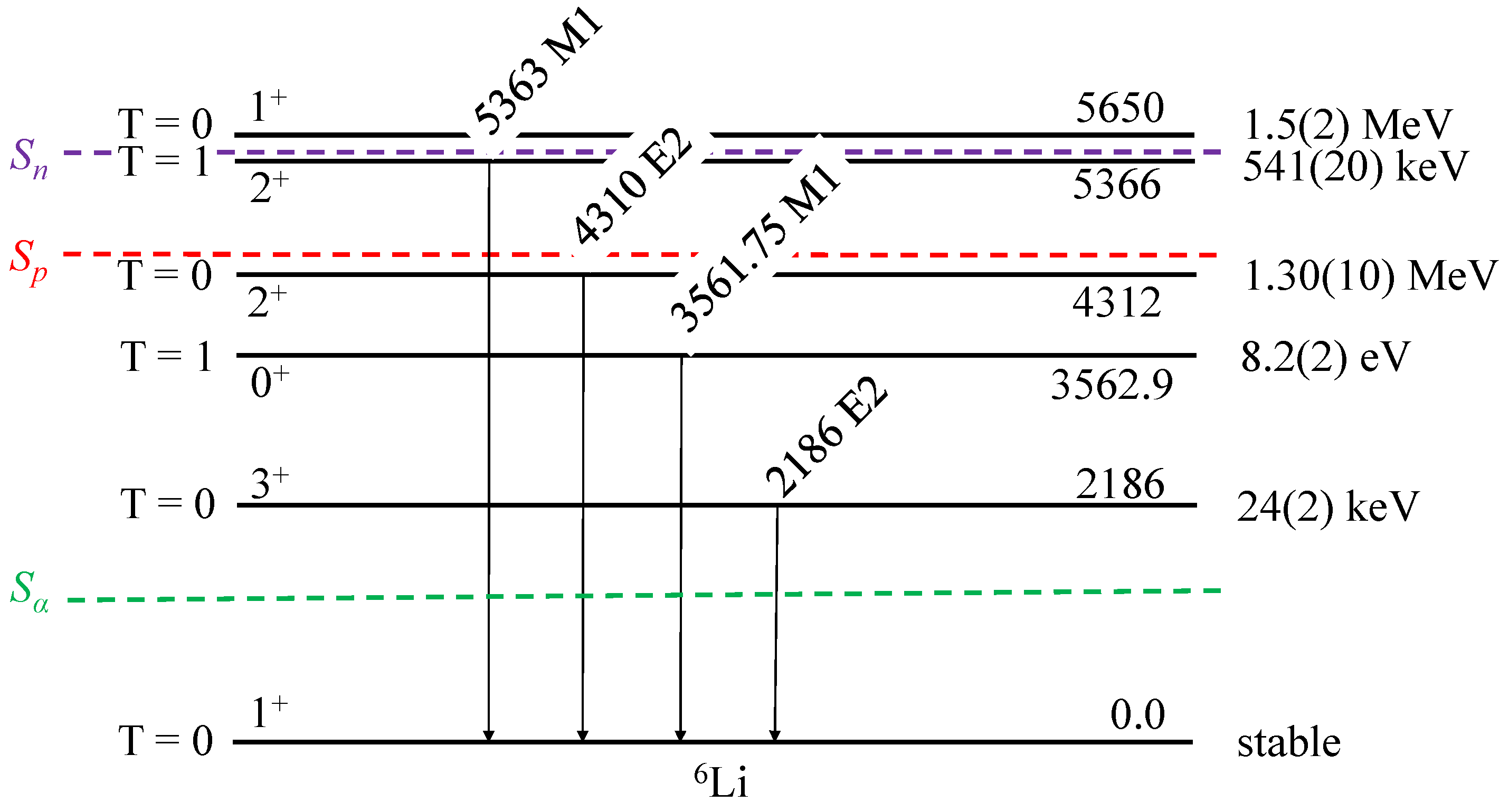
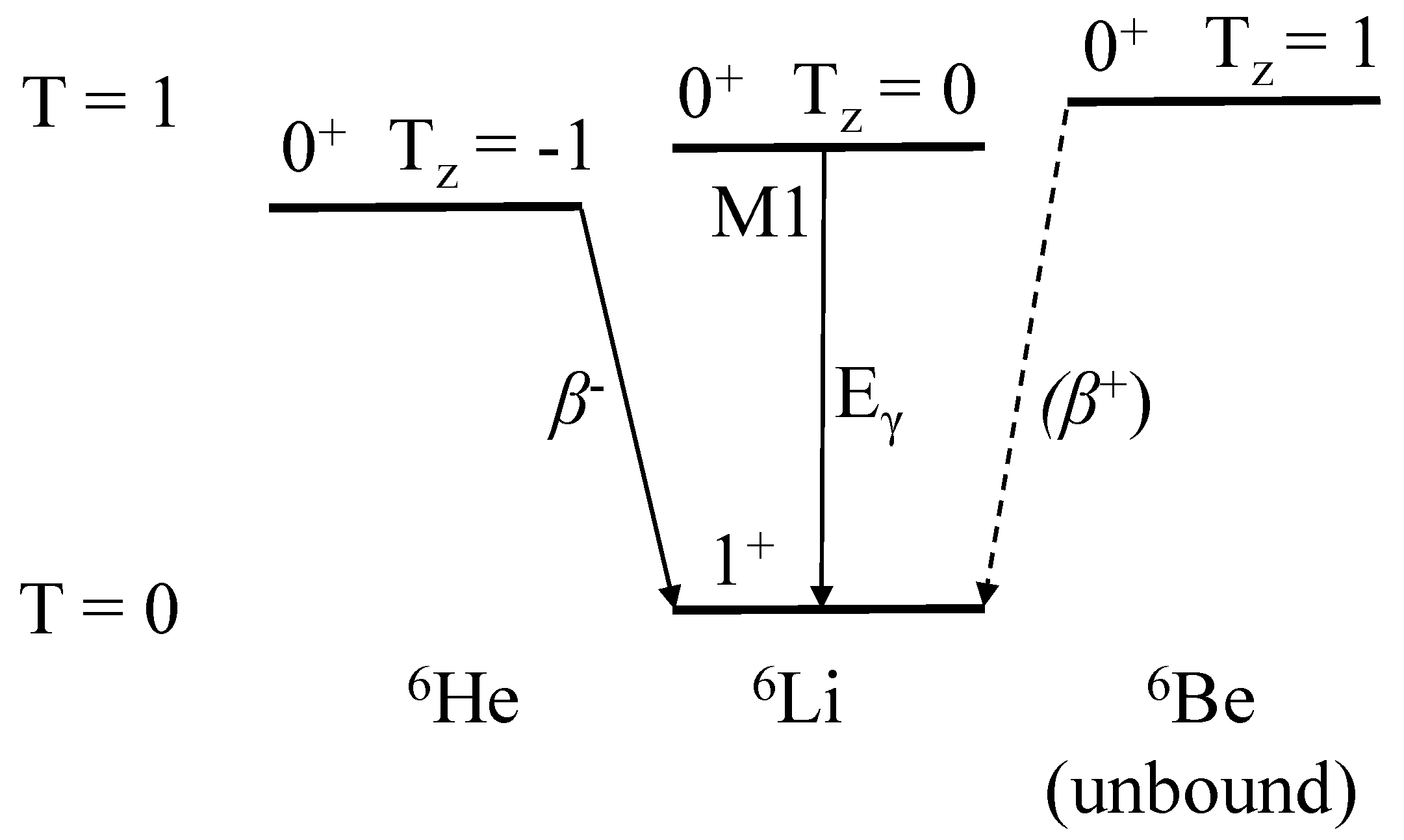
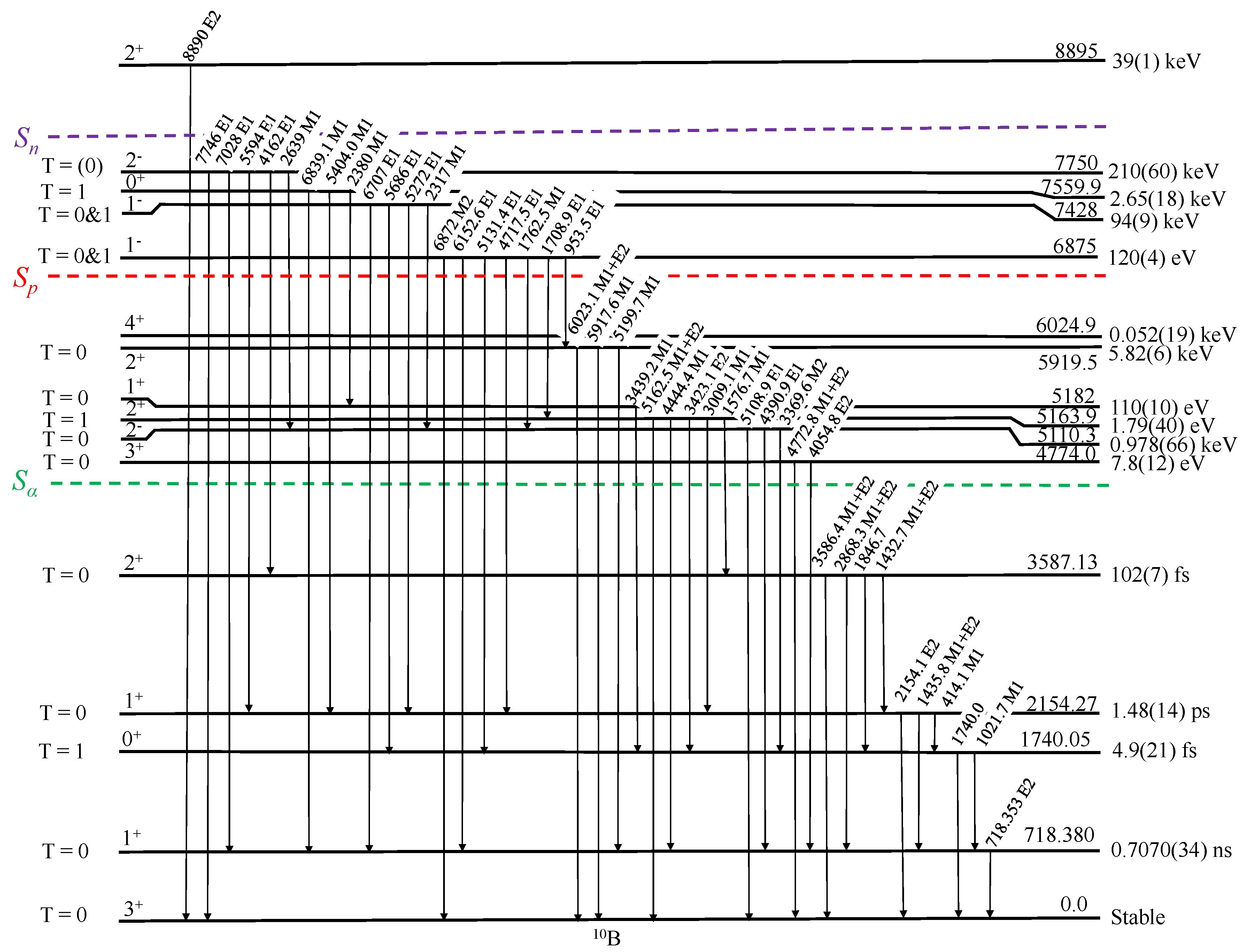
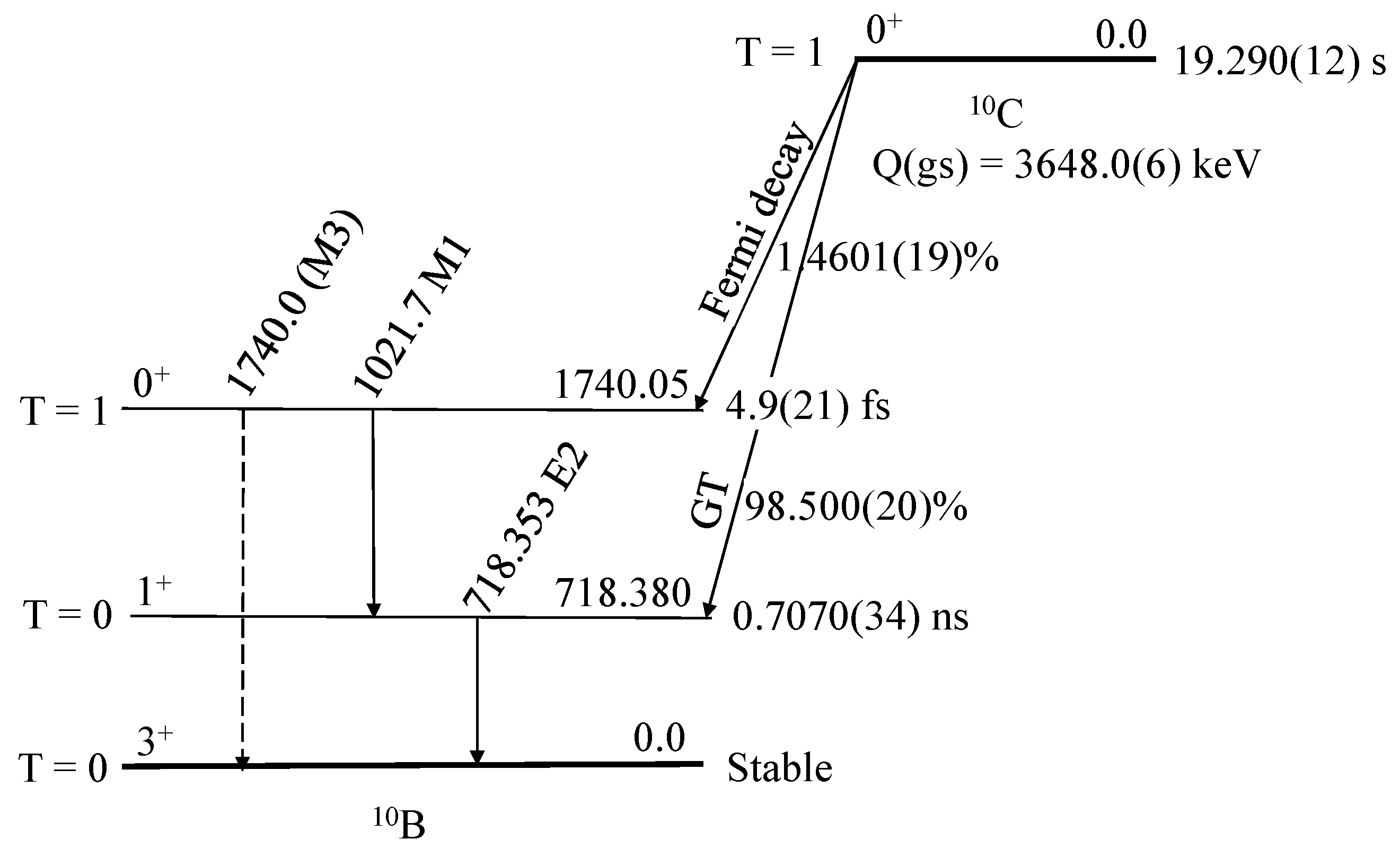
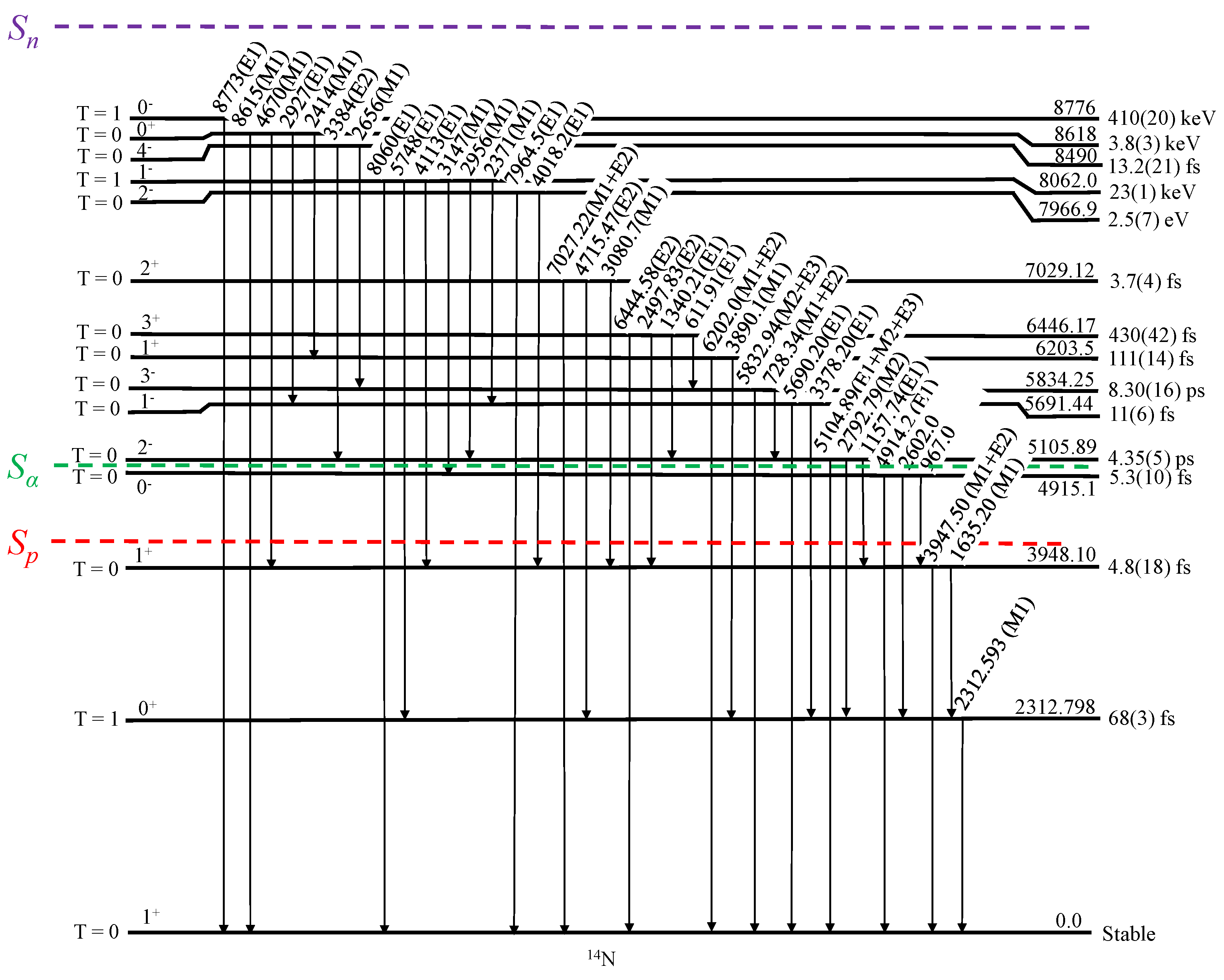
| (keV) | (keV) | (keV) | Ref. [41] | Ref. [42] | Ref. [43] | Ref. [44] | Ref. [45] | Ref. [46] | Ref. [47] |
|---|---|---|---|---|---|---|---|---|---|
| 1740.05 | 0.0 | 1740.0 | - | - | - | <0.2 | <0.5 | <0.5 | - |
| 718.380 | 1021.7 | - | 100 | - | 100 | 100 | 100 | - | |
| 2154 | 0.0 | 2154.1 | - | 16 | 27(7) | 24 | 17.5(20) | 20.2(14) | 17.5(4) |
| 718.380 | 1435.8 | - | 29 | 26(6) | 23 | 26.3(20) | 28.6(20) | 24.8(5) | |
| 1740.05 | 414.1 | - | 55 | 47(5) | 53 | 56.2(20) | 51.2(31) | 57.7(6) | |
| 3587 | 0.0 | 3586.4 | 21(5) | - | 18 | 12 | 16.6(20) | 24.2(17) | 16.7(3) |
| 718.380 | 2868.3 | 58(11) | - | 54 | 76 | 68.1(20) | 63.8(19) | 66.0(5) | |
| 1740.05 | 1846.7 | - | - | 10(5) | <0.3 | <5 | <1 | <1 | |
| 2154.27 | 1432.7 | 21(5) | - | 18 | 12 | 15.4(20) | 12.0(9) | 17.3(3) |
| (keV) | (keV) | (keV) | Ref. [48] | Ref. [49] | Ref. [50] | Ref. [51] | Ref. [52] | Ref. [47] |
|---|---|---|---|---|---|---|---|---|
| 5163.9 | 0.0 | 5162.5 | 5(1) | 7 | - | 4.4(4) | - | 7.3(5) |
| 718.380 | 4444.4 | 24(3) | 27 | - | 22.4(6) | - | 55.5(16) | |
| 1740.05 | 3423.1 | 2(1) | - | <0.5 | 0.7(2) | <0.6 | 0.16(4) | |
| 2154.27 | 3009.1 | 69(5) | 57 | - | 64.8(9) | - | 31.7(12) | |
| 3587.13 | 1576.7 | - | 9(2) | 4.5(10) | 7.7(3) | - | 5.3(5) |
Disclaimer/Publisher’s Note: The statements, opinions and data contained in all publications are solely those of the individual author(s) and contributor(s) and not of MDPI and/or the editor(s). MDPI and/or the editor(s) disclaim responsibility for any injury to people or property resulting from any ideas, methods, instructions or products referred to in the content. |
© 2023 by the authors. Licensee MDPI, Basel, Switzerland. This article is an open access article distributed under the terms and conditions of the Creative Commons Attribution (CC BY) license (https://creativecommons.org/licenses/by/4.0/).
Share and Cite
Kuşoğlu, A.; Balabanski, D.L. Renewed Interest in Spectroscopy of the Lightest Doubly-Odd N = Z Nuclei. Quantum Beam Sci. 2023, 7, 28. https://doi.org/10.3390/qubs7030028
Kuşoğlu A, Balabanski DL. Renewed Interest in Spectroscopy of the Lightest Doubly-Odd N = Z Nuclei. Quantum Beam Science. 2023; 7(3):28. https://doi.org/10.3390/qubs7030028
Chicago/Turabian StyleKuşoğlu, Aslı, and Dimiter Loukanov Balabanski. 2023. "Renewed Interest in Spectroscopy of the Lightest Doubly-Odd N = Z Nuclei" Quantum Beam Science 7, no. 3: 28. https://doi.org/10.3390/qubs7030028
APA StyleKuşoğlu, A., & Balabanski, D. L. (2023). Renewed Interest in Spectroscopy of the Lightest Doubly-Odd N = Z Nuclei. Quantum Beam Science, 7(3), 28. https://doi.org/10.3390/qubs7030028






